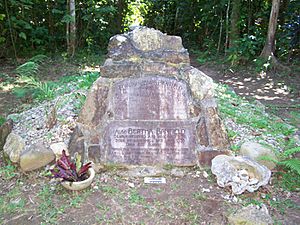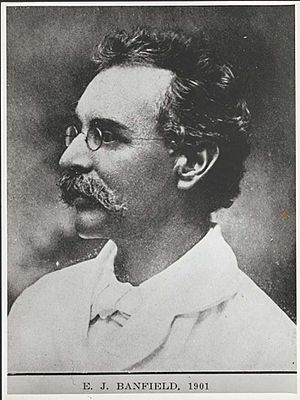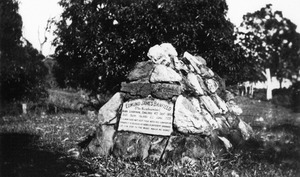Banfield Memorial Reserve and Grave facts for kids
Quick facts for kids Banfield Memorial Reserve and Grave |
|
|---|---|

Banfield Memorial Reserve and Grave, 2008
|
|
| Location | Dunk Island, Cassowary Coast Region, Queensland, Australia |
| Built | 1923-1933 |
| Official name: Banfield Memorial Reserve and Grave | |
| Type | state heritage (built) |
| Designated | 6 August 2010 |
| Reference no. | 602755 |
| Lua error in Module:Location_map at line 420: attempt to index field 'wikibase' (a nil value). | |
The Banfield Memorial Reserve and Grave is a special heritage site on Dunk Island in Queensland, Australia. It is a single grave that was built between 1923 and 1933. This important place was added to the Queensland Heritage Register on 6 August 2010.
It honors Edmund James (Ted) Banfield, a famous author and naturalist. He was known as "The Beachcomber" because of his popular books about the island's plants and animals. Banfield helped protect Dunk Island and the nearby Family Islands National Park. He also made a type of nature-focused tourism, called eco-tourism, very popular in the Great Barrier Reef area.
The Story of Edmund Banfield
Early Life and Influences
Edmund (Ted) James Banfield was born in Liverpool, England, on September 4, 1852. His family moved to Australia in 1858. Ted followed his father into journalism, but he loved studying nature and reading. He was greatly inspired by Henry David Thoreau, an American writer. Thoreau wrote about living simply in nature and being self-reliant. Banfield later said Thoreau's ideas encouraged him to seek new experiences.
Moving to Queensland
Banfield worked for newspapers in Melbourne and Sydney. In 1882, he became a sub-editor for the Townsville Daily Bulletin. He became a strong supporter of the idea for North Queensland to become a separate state. In 1884, he traveled to England for eye treatment. He met Bertha Golding there, and she later moved to Townsville where they married in 1886.
Finding a Home on Dunk Island
In the 1890s, Banfield's health got worse. To help him recover, he and his wife camped on Dunk Island in 1896. This island is part of the Family Islands group, off the coast from Mission Beach. He felt much better after this trip. This experience made him want to find a home among these islands. He finally chose Dunk Island and leased a small area there in September 1897.
Banfield had tuberculosis and was very stressed. He and Bertha moved to the island on September 28, 1897, for a six-month trial. They were the only Europeans living there at first. They lived in tents and later built a small hut and planted crops.
Building a Life on the Island
With his health much better, Banfield worked on his new home. He used timber from a mill on the mainland. He also planted coconut trees to create a long path from his house to the beach. In 1900, he was granted a selection of 320 acres (129 hectares) on the western side of Dunk Island. By 1905, his property had a house, a kitchen, a laundry, a storehouse, and areas for animals and plants.
From 1898, Banfield kept a daily record of his life on Dunk Island. He watched the island's natural cycles and paid close attention to the local plants and animals. He also learned about the way the local Aboriginal people, the Bandjin and Djiru, lived with the environment. He recorded their names for places, plants, and animals. This was very important because the local Aboriginal people were later moved to missions.
Protecting Nature
Banfield became very interested in protecting bird habitats. He wrote to Robert Philp, who was the Premier of Queensland at the time. Banfield suggested that the Family Islands should be made a sanctuary for birds. He offered to be an Honorary Warden to help protect them. On May 10, 1905, the islands were officially declared a Reserve for the Protection and Preservation of Native Birds. Banfield was named an Honorary Ranger on June 24, 1905.
Banfield's Famous Books
Banfield kept a regular writing schedule. He wrote about his experiences and observations. He sold his writings to earn money. In 1908, he published Confessions of a Beachcomber. This book became his most successful work and was translated into many languages. It was like a diary, a study of local culture, and a nature notebook all in one. Nature magazine called it a "classic for naturalists." Banfield became widely known as "The Beachcomber."
He wrote three other books about Dunk Island: My Tropic Isle, Tropic Days, and Last Leaves from Dunk Island. Last Leaves was published after he died in 1925. It included detailed notes about a terrible cyclone in 1918 that hit the island. Many of his writings first appeared as articles in newspapers.
His Legacy
Banfield died in 1923 at age 70 from appendicitis. He was a well-known author, and his death was reported in major Australian newspapers. At a writers' festival in 1929, his work was praised worldwide. His writings inspired artists, naturalists, and tourists from Australia and other countries. Many people visited the island because of his books.
The Grave Site
After Banfield's death, Spenser McTaggart Hopkins buried him on his Dunk Island property. The grave is on high ground north of where Banfield's house was. Hopkins built a stone pile, called a cairn, over the grave. He also added a marble tablet with a quote from Thoreau.
Bertha Banfield lived for another ten years. When she died in 1933, Spenser Hopkins placed her ashes next to her husband's grave. He added a second tablet to the cairn. The grave has stayed untouched on Dunk Island, even as the island's ownership and use changed over time.
In 1936, most of Dunk Island was made a national park. This was an area Banfield had worked hard to protect. The northern part of the island, including Banfield's former property, became a tourist resort from the 1930s. Over the years, the resort was developed and changed hands many times. The only structure from Banfield's time that still exists is the cairn marking his and his wife's grave.
On January 28, 1971, a special area of land around Banfield's grave was set aside as a Reserve for Museum (Banfield Memorial) Purposes. James Cook University became its trustee. There were plans to create a museum to honor Banfield's contributions to literature and nature. However, a museum has not yet been built. The reserve is still managed by James Cook University.
What the Grave Looks Like
Banfield's Grave is in a clear area on a memorial reserve on Dunk Island. This small island is about four kilometers off the coast of far north Queensland. The grave and its stone cairn are on high ground. They are about 500 meters (1,640 feet) north-east of the main resort area.
The grave site is a popular historical spot. You can reach it from the resort by following a narrow concrete path. This path has signs to guide you. It leads through thick plants to a clearing in the rainforest. The grave, marked by the cairn, is in the middle of this clearing. An old mango tree, seen in early photos, is to the south of the path.
The Cairn and Tablets
The cairn is built from rough stones and mortar. It has oyster and other shells stuck into the mortar. It is shaped like a triangle, with the top leaning towards the east. Two marble tablets are set into the eastern side.
The first tablet honors Edmund Banfield. It has his name, birthplace, dates, and a famous quote from Henry David Thoreau:
Edmund James Banfield The Beachcomber Born Liverpool, England, 4th September 1852 Died Dunk Island, 2nd June 1923 If a man does not keep pace with his companions perhaps it is because he hears a different drummer. Let him step to the music which he hears.
Below this, a second tablet honors Bertha Banfield. It says:
Also Bertha Banfield Dearly beloved and honoured wife Born at Liverpool 19th JanY 1858 Died 6th August 1933 Whither thou goest I will go, and where thou lodgest I will lodge ---- where thou diest, will I die and There will I be buried.
Around the cairn, there is a bed of white quartz pebbles. These are held in place by granite rocks. Next to the eastern side of the cairn are a giant clam shell and a stone bowl. These items were added later and are not part of the original historical site. Beyond the clearing, the reserve is covered with thick rainforest.
Why This Site is Important
The Banfield Memorial Reserve and Grave was listed on the Queensland Heritage Register on August 6, 2010. It is important for several reasons.
Showing Queensland's History
This place helps us understand the history of Queensland. It honors Edmund James Banfield, who was the first European settler on Dunk Island. He was a famous author and naturalist who worked to protect the plants and animals of the Family Islands. His efforts were very important for the early history of nature conservation in Queensland. He also helped popularize "eco-tourism." Both his grave (from 1923) and the reserve around it (created in 1971) are memorials to Banfield. They show his dedication to protecting the natural environment.
Connection to a Special Person
The memorial reserve and grave are strongly connected to E.J. Banfield. He greatly improved our understanding of tropical environments between 1897 and 1923. He also learned about the Aboriginal Traditional Owners of the Family Islands before they were moved to missions. His books about Dunk Island's nature and culture made him famous as a naturalist. His work inspired many naturalists, artists, and authors from around the world to visit north Queensland and the Great Barrier Reef islands.




